Press Release
Johns Hopkins Applied Physics Lab to Lead NASA Solar System Exploration Research Institute Team
NASA has tapped the Johns Hopkins University Applied Physics Laboratory in Laurel, Md., to look into the processes that shape the surfaces of the moon and asteroids — and provide insight into potential robotic and human exploration of these surfaces and the resources they might harbor.
As part of NASA’s new Solar System Exploration Research Virtual Institute, APL space scientist Benjamin Bussey will head the Volatiles, Regolith and Thermal Investigations Consortium for Exploration and Science (VORTICES) team. VORTICES includes more than 40 co-investigators and collaborators from the U.S. and abroad, including the Homewood campus of the Johns Hopkins University. By combining the talents and facilities of different researchers at multiple institutions, the VORTICES team will tackle problems of interest to NASA’s science and human operations mission directorates.
Funded for a five-year study, VORTICES will build on the work of a NASA Lunar Science Institute team — also led by APL’s Bussey — that studied the polar regions of the moon, whose geology and potential for storing ice were largely unknown.
“The goal of our previous NLSI team was to transform ‘Luna incognita’ into ‘Luna cognita,’” Bussey says. “Now that we know more about how such processes operate on a large, low-gravity body with only a tenuous exosphere, the VORTICES team can extend that work in several directions, including deepening our understanding of the moon, and addressing important questions for exploring near-Earth asteroids and [Martian moons] Phobos and Deimos.”
By examining data from past and operating space science missions and conducting theoretical and laboratory studies, VORTICES researchers will address a series of themes, including how and where volatiles (such as water) form, how they interact with the surface, and how they end up stored on or removed from the surface. The team will also look at how regolith forms and evolves, and how the distribution of volatiles and sunlight across the surfaces of our moon, asteroids and the Martian moons could enable robotic and human exploration.
VORTICES is one of nine teams in NASA’s Solar System Exploration Research Virtual Institute (SSERVI), formed this year to expand the work of the NASA Lunar Science Institute to other planetary bodies. For more information, visit http://sservi.nasa.gov/.
